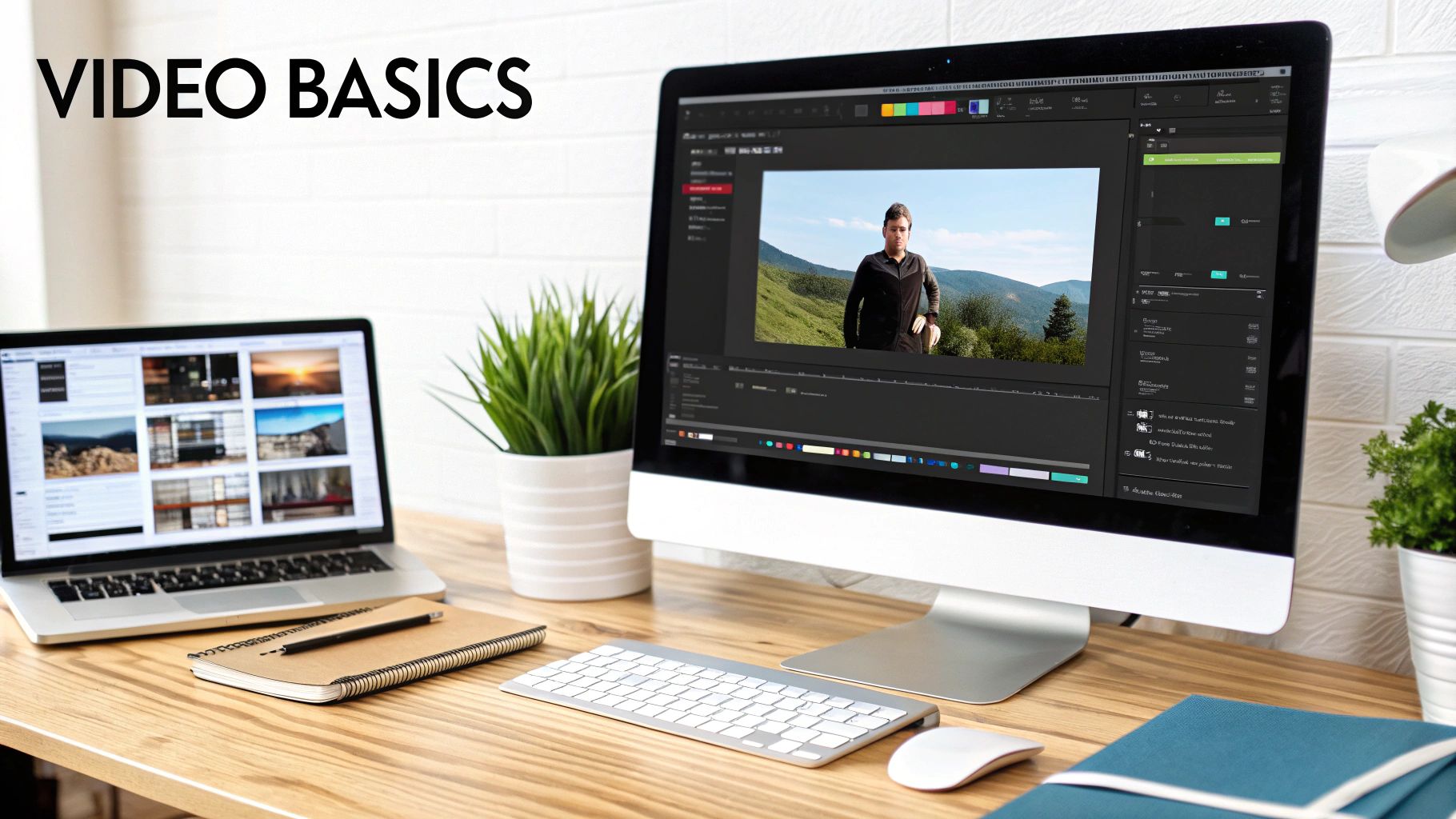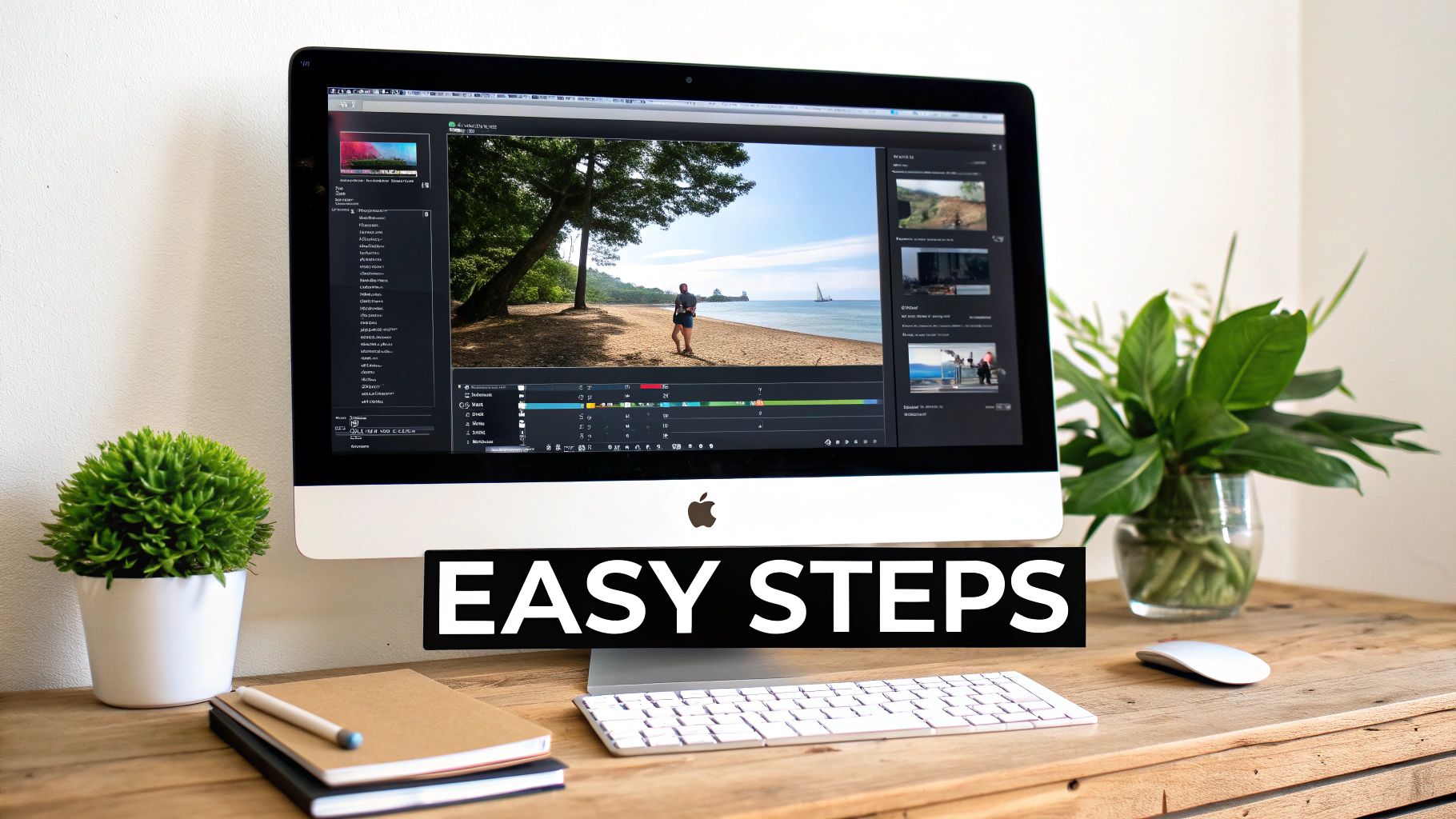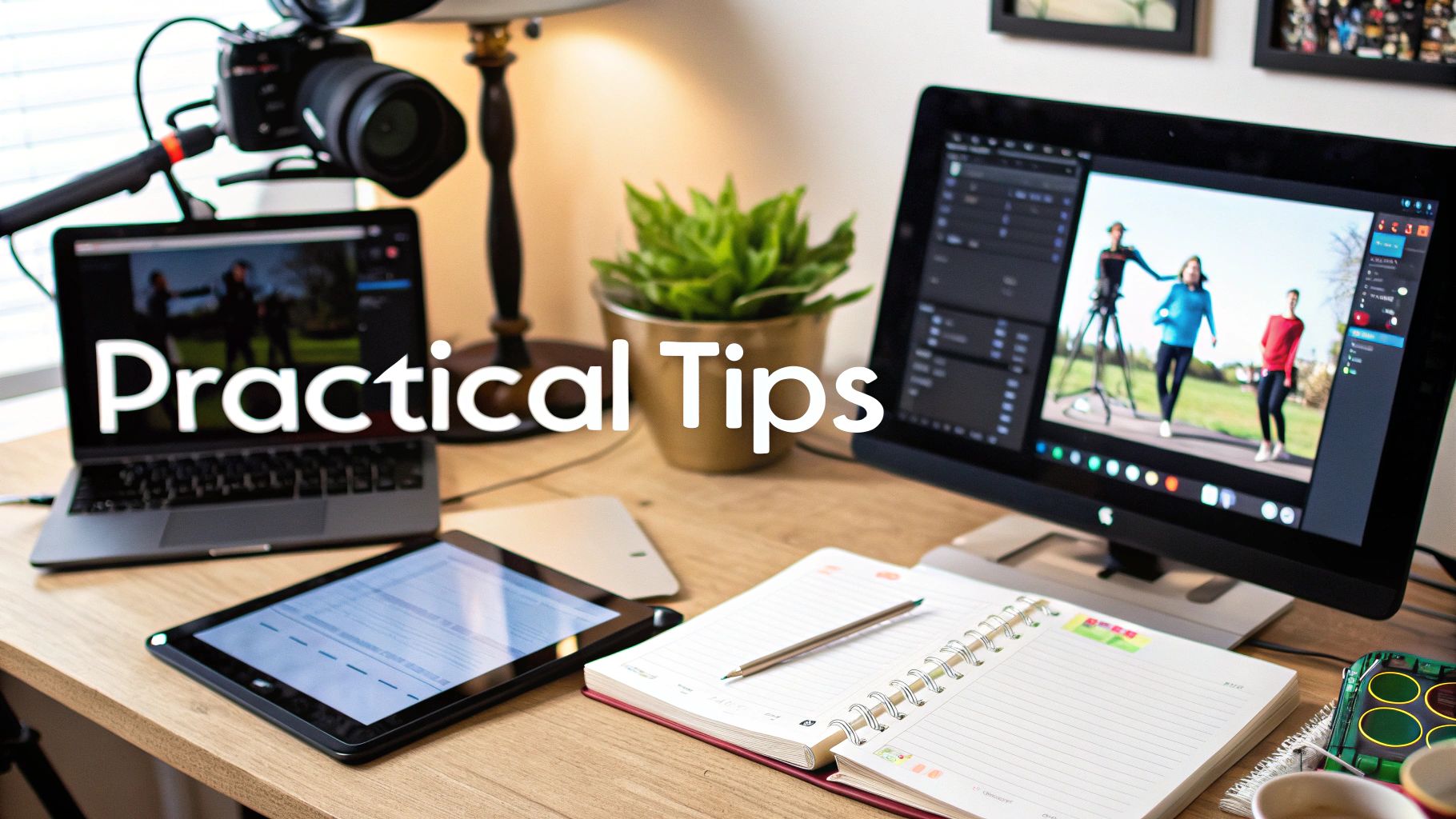How to Remove Background from Video - Expert Guide
Discover how to remove background from video using expert techniques and professional tools. Transform your visuals with this complete guide!
The Evolution of Video Background Removal

Removing the background from video footage has come a long way, transforming filmmaking and video production. Once a laborious manual process, it required specialized skills and significant resources, limiting high-quality background removal to large productions with substantial budgets.
Early background removal techniques involved clever in-camera tricks and darkroom manipulation. Double exposure, filming a scene twice on the same film strip, allowed for compositing different elements. However, these methods were time-intensive and often resulted in imperfections. The advent of chroma keying (using a green screen or blue screen) marked a major step forward, allowing for easier background replacement in post-production.
This dependence on specific equipment and expertise posed a challenge for independent creators and smaller projects. The rise of digital tools helped simplify the process. Early digital video editing software introduced masking and keying features, giving users more control over manual background removal.
The history of background removal in video stretches back to the 19th century. Georges Méliès, a French filmmaker, employed compositing techniques as early as 1898. He famously created the illusion of a man removing his head by combining different frames. In the early 20th century, filmmakers like Edwin Porter utilized double exposure to create backgrounds, as seen in 'The Great Train Robbery.' These early, labor-intensive methods paved the way for the modern tools we have today. Learn more about the captivating history of background removal. Explore this topic further
The Rise of AI-Powered Background Removal
The introduction of AI-powered tools is a significant advancement in background removal. Sophisticated algorithms automatically identify and separate the foreground subject from the background, dramatically reducing time and effort. Services like VideoBGRemover use this technology to provide high-quality background removal for various video formats (MP4, MOV, and WEBM) with HD 1080p output. This has democratized the process, making it accessible to anyone with a computer and internet connection.
The Impact on Creators
This evolution has empowered creators of all levels. A formerly complex and costly process is now readily available, enabling individuals and small businesses to produce professional-quality videos. Content creators can now prioritize their creative vision, no longer burdened by the technical challenges of video editing. Accessible AI-powered background removal tools have also unlocked new creative avenues, allowing filmmakers and video producers to easily experiment with diverse backgrounds and visual effects.

From simple online tools to sophisticated software, the options for removing video backgrounds are plentiful. Choosing the right tool depends on your project's specific needs. A quick social media post might only need a simple online tool. However, professional projects often demand more robust software solutions.
Software Solutions For Precise Control
Professional video editing software like Adobe Premiere Pro provides powerful background removal features. These tools give you granular control, allowing for precise masking and keyframing. This precision is essential for complex scenes with intricate details or quick movements. However, mastering these tools often requires a substantial time investment.
Consider these aspects when choosing between software solutions:
- Complexity of your video: How many elements are moving in the foreground? How detailed is the background?
- Level of precision: Do you need pixel-perfect removal, or is a good approximation sufficient?
- Time commitment: How much time are you willing to invest in learning the software and refining the process?
Online Tools For Speed and Accessibility
Online tools such as VideoBGRemover provide a convenient and accessible way to remove backgrounds. These AI-powered platforms automate much of the process, making it faster than manual methods. They’re ideal for users needing quick results without extensive editing experience. VideoBGRemover, for example, supports several video formats (MP4, MOV, and WEBM) and offers 1080p HD output. This ensures quality results while streamlining the workflow.
Specialized Plugins For Advanced Effects
For advanced effects and fine-tuning, specialized plugins can integrate with professional editing software. These plugins often use advanced algorithms to handle challenging footage, such as moving hair or transparent objects. While they add cost and complexity, they can significantly improve the final product’s quality. Plugins like BCC+ Linear Color Key offer advanced features for precise color keying and background removal, allowing for seamless integration of foreground subjects onto new backgrounds.
Mobile Apps For On-The-Go Editing
Mobile apps now offer basic background removal functionality for quick edits on smartphones and tablets. While lacking the advanced features of desktop software, their portability and ease of use make them valuable for content creators on the go. These apps are often suitable for simple background removal tasks, especially for social media.
To help you choose the right tool, we’ve compiled a comparison table highlighting the key features, pricing, and ideal use cases of several popular background removal tools.
To make the selection process easier, let's compare some popular video background removal tools. The following table outlines the key features and pricing of each:
Video Background Removal Tools Comparison Comprehensive comparison of the top background removal software options for videos, highlighting key features, pricing, and ideal use cases
| Tool Name | Platform | Ease of Use | Output Quality | AI Features | Price Range |
|---|---|---|---|---|---|
| Unscreen | Web, API | Very Easy | High | AI-powered automatic removal | Free, paid plans |
| Kapwing | Web | Easy | Medium | Basic AI features | Free, paid plans |
| Adobe Premiere Pro | Desktop | Advanced | High | Some AI features | Paid subscription |
| Final Cut Pro | Desktop | Advanced | High | Limited AI features | One-time purchase |
| VideoBGRemover | Web | Easy | High | AI-powered automatic removal | Free, paid plans |
| Remove.bg | Web | Easy | High | AI-powered automatic removal | Free, paid plans |
This table provides a quick overview of various video background removal tools, categorized by their platform, ease of use, output quality, AI capabilities, and price range. As you can see, there are options available for different levels of expertise and budget.
Choosing The Right Tool For Your Needs
Choosing the best video background removal tool requires careful consideration of several factors:
- Footage complexity: Simple backgrounds and static subjects may only require an online tool or mobile app.
- Desired precision: Professional software or specialized plugins are best for complex backgrounds, fast movement, or fine details.
- Budget: Free online tools are a good starting point, but professional-grade results often require investing in paid software or plugins.
For instance, removing a solid-colored background from a product video is easy with an automated online tool. However, removing the background from a video of a dancer with flowing hair—a task involving fine details and motion blur—requires a more powerful tool. For additional insights, you might find this helpful: 7 Best Video Background Removal Tools for Content Creators.
Choosing the right tool improves efficiency and ensures high-quality output. This careful selection process is crucial for professional results and maximizing your videos’ impact.
Step-By-Step: Remove Background From Video Like A Pro

Removing a video's background unlocks countless creative opportunities. You can replace it with something simple, like a solid color, or something more complex, like a dynamic scene. This process, once a specialized skill, is now easily accessible thanks to intuitive software and online tools. This guide will show you how to remove a video background like a pro.
Choosing The Right Approach
The best approach depends on your video and the tools you have available. For simple backgrounds and basic removal, a free online tool like VideoBGRemover offers a quick and easy solution. For videos with complex backgrounds, fine details, or rapid movement, you might need the precision of professional software like Adobe Premiere Pro. Within Premiere Pro, you can use built-in features or explore dedicated plugins for more refined results. For further guidance, check out this helpful resource: How to master video background removal with step-by-step guidance.
Preparing Your Video
Before starting, make sure your video is in the right format. This might involve converting it to a compatible format like MP4, MOV, or WEBM. Online tools usually have a simple upload process. With software like Premiere Pro, you'll import your video into a project file. Proper preparation will make the entire process smoother and more efficient.
The Background Removal Process
Here's how to remove a video background using common methods:
Using An Online Tool (e.g., VideoBGRemover): Upload your video. The AI-powered platform automatically detects and separates the foreground from the background. Preview the result and download your background-free video.
Using Software With Built-in Tools: Import your video. For videos shot with a green screen or blue screen, use the chroma key features. For more complex backgrounds, use masking tools to manually select and remove the background. This often involves creating a mask around your subject and tracking its movement frame by frame.
Using Dedicated Plugins: Install the plugin and integrate it with your editing software. Apply the effect to your clip and adjust the settings for optimal results. Plugins often offer advanced algorithms to handle tricky scenarios, such as fine hair or transparent objects.
The increasing availability of background removal tools reflects a broader industry trend. By 2021, major video conferencing platforms like Google Meet, Microsoft Teams, and Skype had integrated background removal features. Discover more insights about this topic. Google Meet uses MediaPipe for its background removal, demonstrating how real-time video processing has become a standard feature.
Refining Your Results
After removing the background, you can refine the edges for a polished look. Many tools offer features to smooth edges or adjust transparency. Professional software often provides more granular control, allowing for frame-by-frame editing and specialized effects.
Adding A New Background (Optional)
With the background removed, you can add a new one. This could be a solid color, a still image, or another video clip. In your video editing software, place the new background layer behind your subject on the timeline. Adjust its position and scale as needed.
Exporting Your Video
Finally, export your finished video in your preferred format and resolution. VideoBGRemover offers HD 1080p output. Ensure your export settings preserve the video quality and frame rate. Software like Premiere Pro provides greater flexibility over codec and bitrate choices. This final step prepares your video for sharing on social media, using in presentations, or integrating into film projects.
Advanced Techniques For Enhanced Video Background Removal

Removing a video's background is a nuanced process that goes beyond a simple click. Achieving professional-grade results requires careful attention to detail and a mastery of advanced techniques. This is the key differentiator between impactful video content and average edits. Whether you're a seasoned video editor or just beginning, these techniques can significantly elevate the quality of your work.
Maintaining Realistic Edge Detail
A common challenge in background removal is preserving realistic edges around the foreground subject. Poorly defined edges can make the final composition appear artificial. Rotoscoping, a technique involving manually tracing the subject's outline frame by frame, offers a solution for clean, accurate edges. Furthermore, advanced software packages like Adobe After Effects often include edge-refinement tools. These tools analyze the image and automatically enhance edge detail, even in complex scenarios like hair or fur. This meticulous approach ensures seamless integration between your subject and the new background.
Preserving Natural Motion Blur
Motion blur, a natural effect occurring when an object moves quickly during filming, is crucial for realism. Preserving this blur after background removal is essential. Some background removal tools struggle with motion blur, resulting in noticeable artifacts. However, more sophisticated tools can analyze motion vectors in the video, accurately preserving the natural blur. AI-powered platforms like VideoBGRemover utilize specialized algorithms designed specifically for handling motion blur, contributing to a more natural and convincing final product.
Handling Complex Lighting Interactions
Managing the interaction of light with the subject is another key aspect of realistic compositing. If the original background was bright and the new background is dark, the subject's lighting may need adjustments to match. This often involves techniques like color grading and shadow manipulation. Careful consideration of the original lighting and its interaction with the new background adds a subtle layer of realism that significantly impacts the overall quality.
Tackling Challenging Scenarios
Certain situations, such as semi-transparent objects, reflective surfaces, or dynamic camera movements, demand even more advanced techniques. Refraction and reflection mapping accurately depict light interaction with transparent or reflective materials. For dynamic camera movements, 3D camera tracking precisely matches the movement of the subject and background. These advanced techniques, often found in professional video editing software, provide the control needed for high-precision background removal in complex video projects.
Creative Uses of Transparent Videos
Removing a video's background unlocks a wealth of creative opportunities, changing how we interact with and share video content. From marketing and education to entertainment and digital art, transparent videos are revolutionizing how we tell stories and present information.
Transforming E-Commerce with Transparent Product Videos
E-commerce businesses are utilizing background removal to present products in innovative and engaging ways. Imagine a product video where the background seamlessly shifts from a lifestyle setting to a detailed technical demonstration. This allows viewers to envision the product in their own lives while also understanding its features and functionality. By removing the background, brands can maintain consistent branding across various platforms and seamlessly incorporate products into different marketing materials. This can lead to increased conversion rates as customers connect with the product on a deeper level.
Enhancing Education With Engaging Visuals
Transparent videos also offer exciting new avenues for education. Educators can insert themselves directly into presentations or overlay instructional videos onto related images and diagrams. Imagine a biology teacher explaining the human circulatory system while appearing to stand inside a beating heart! This interactive approach makes learning more captivating and helps students grasp complex concepts more easily.
Reimagining Entertainment and Digital Art
Content creators are embracing transparent videos to produce eye-catching visual effects, helping them stand out on platforms like TikTok and Instagram. This allows them to transport themselves to far-off locations or seamlessly blend into animated scenes, grabbing attention and fostering greater engagement. The ability to remove backgrounds adds a new layer of creativity to video production, allowing for unique and captivating content.
Transparent Videos in Specialized Fields
Beyond entertainment, transparent videos are also proving valuable in specialized fields. In civil engineering, for instance, background removal plays a crucial role in structural analysis. Engineers are using video analysis with background removal to assess cable forces on bridges, offering a less invasive method than traditional approaches. One such algorithm, RGv2, combines the Region Growing algorithm with cable structural characteristics, providing improved computational efficiency compared to deep learning. You can explore this topic further and learn more about this fascinating application.
The Future of Transparent Videos
As technology progresses, we can anticipate even more innovative applications for transparent videos. Augmented reality (AR) experiences can become more immersive, and virtual events can integrate real-world components with increased realism. The ability to manipulate and incorporate video footage in real-time opens doors to interactive storytelling, personalized advertising, and entirely new forms of digital expression. The possibilities are vast as this technology continues to develop.
Troubleshooting Common Video Background Removal Problems
Removing a video's background is simpler than ever, but challenges can still arise. Even with advanced AI tools like Unscreen, you might encounter issues that require troubleshooting. This guide addresses common problems and provides solutions to help you achieve polished, professional results.
Common Problems and Their Solutions
One frequent issue is color contamination. This occurs when remnants of the original background color bleed onto the foreground subject. It’s particularly common with green screen footage, often appearing as a greenish tinge, especially around the edges. Adjusting the color key settings and the spill suppression controls in your video editing software, such as Adobe Premiere Pro or DaVinci Resolve, is the typical solution.
Another common problem is edge flickering. The edges of the foreground might appear to shimmer or shift between frames. This can be caused by inconsistent lighting or movement between frames. Stabilizing the footage or using more advanced masking techniques within your editing software can help mitigate this. You can explore resources like this helpful blog post for more in-depth information.
Inconsistent masking across frames poses another challenge. If the mask doesn't accurately follow the subject's movement, the background might peek through, or parts of the foreground could be clipped. Refining the mask tracking by adding keyframes or adjusting tracking parameters is often necessary.
Finally, fine details, such as hair or transparent objects, can be difficult for background removal algorithms to handle. For accurate results in these situations, you might need specialized plugins or manual rotoscoping techniques.
To help you further, we’ve compiled a table summarizing these common background removal problems, their causes, solutions, and prevention tips.
Introducing a helpful table outlining frequent background removal issues, their causes, solutions and ways to avoid them:
| Problem | Cause | Solution | Prevention Tips |
|---|---|---|---|
| Color Contamination | Background color bleeding onto foreground | Adjust color key/spill suppression settings in your editing software | Ensure even lighting during filming |
| Edge Flickering | Inconsistent lighting/motion blur | Stabilize footage, refine masking techniques | Use consistent lighting, avoid fast movements near edges |
| Inconsistent Masking | Poor mask tracking | Adjust keyframes/tracking parameters | Use a stable camera and ensure clear contrast between foreground and background |
| Issues with Fine Detail (Hair, Transparent Objects) | Algorithm limitations | Specialized plugins, rotoscoping | Consider background choice during filming, avoid complex details if possible |
This table provides a quick reference for identifying and resolving common background removal issues. Remember, prevention is often easier than correction, so consider these prevention tips during your filming process.
Diagnosing the Root Cause
Identifying the root cause is crucial for effective troubleshooting. If your subject's edges are jagged or pixelated, the problem might not be the background removal process itself, but rather the video's resolution or compression settings. Similarly, an incomplete background removal could stem from the initial masking or keying, not the refinement stages.
A systematic approach—starting with the basics and moving to advanced techniques—is key. This can save you valuable time and frustration. First, check your source footage for issues. Then, review your initial masking and keying. Finally, examine the specific background removal settings.
By understanding the underlying issues and implementing the right solutions, you can overcome challenges and enhance your video editing skills. Don’t settle for less than professional quality. Achieve seamless background removal with VideoBGRemover, the AI-powered tool that simplifies the process.
Tagged with
Ready to Remove Your Video Background?
Try our AI-powered background remover for free. See results before you buy.
No credit card required • Free preview on every video